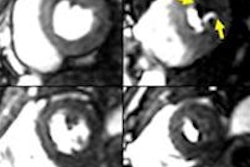Can an ultrasound scanner be controlled robotically by an operator thousands of miles away? It's not just a dream, according to an international team of researchers who demonstrated the feasibility of robot-assisted echocardiography in a pair of articles published recently in JACC: Cardiovascular Imaging.
In the first study, researchers from the Icahn School of Medicine at Mount Sinai Hospital described how the use of a small robotic arm with built-in ultrasound technology could be remotely controlled to perform a scan of a carotid artery from across the world via a low-bandwidth Internet connection.
Meanwhile, a second study performed in collaboration with Umeå University in Sweden found that the combination of a cardiology video consultation with robot-assisted remote echo could expedite patient diagnosis and management.
A research team led by Dr. Partho Sengupta of the Icahn School of Medicine first tested a prototype medical telerobotic ultrasound system (TeleHealthRobotics) to see if it was feasible for performing long-distance imaging over local Internet service. To determine the learning curve for sonographers, the researchers also evaluated the blinded interactions of a beginner and an experienced sonographer in their operation of the robotic arm's software control system (JACC Cardiovasc Imaging, August 2014, Vol. 7:8, pp. 804-809).
Two long-distance stations -- one in New York City and one in Munich, Germany -- were used to successfully scan a vascular ultrasound phantom and a human volunteer at a site in Burlington, MA, over standard Internet bandwidth of less than 100 Mbps (New York City) and less than 50 Mbps (Munich). The robotic ultrasound exam of the volunteer's neck was completed in just four minutes from Germany.
"Our evaluation suggests that long-distance telerobotic vascular ultrasound over a local nondedicated Internet connection is feasible and can be rapidly learned by experienced sonographers for cost-effective resource utilization," the authors concluded. "These advances are particularly relevant for the emerging field of telemedicine and will help address the existing deficiencies in global healthcare access."
Experience helps, but it's not necessary
From comparing the sonographers with different experience levels, the researchers found that "although proficiency in using ultrasound was not a prerequisite for operating the robotic arm, previous experience in using clinical ultrasound was associated with progressively lower probe maneuvering time and speed due to an enhanced ability of the veteran operator in adjusting the finer angular motions of the probe."
With long-distance telerobotic ultrasound, sonographers and physicians could serve as a virtual online "helping hand" to provide remote ultrasound evaluation or remotely guide paramedic workers, according to the researchers.
"The emergence of such an efficient system would be valuable in numerous situations; for example, within an institution for guiding emergency triage or interventional procedures, in trauma during civilian accidents or war zones, for screening strategies within local or remote communities, and in natural disasters or remote space expeditions, allowing wider delivery of services more efficiently and cost-effectively," they wrote.
With the successful experience under their belts, the researchers are now moving ahead with a full-scale telerobotic ultrasound human feasibility study that will be performed in two phases and at two institutions.
The first study cohort will include 26 healthy volunteers who will receive two manual and two telerobotic ultrasound studies controlled over the Internet between institutions in Chicago and New York, according to the group. A second cohort will provide one manual and one telerobotic ultrasound study for each of the left and right carotid arteries for detecting carotid plaque in 100 patients.
Faster diagnosis, management
In the second study published in this month's JACC: Cardiovascular Imaging, a team led by Dr. Kurt Boman, PhD, of Umeå University in Sweden with colleagues from the Icahn School of Medicine reported on their experience in evaluating the feasibility and clinical value of performing cardiology video consultations in combination with remote robot-assisted echocardiography.
Following up on a previous pilot project, the group enrolled 38 patients from a primary healthcare center in north Sweden for a prospective trial to determine if time to diagnosis could be decreased by at least one month over standard care practices at the center. Of these 38, 19 patients were randomized to receive remote consultation and imaging, while the remaining 19 were referred to a secondary/tertiary care hospital 65 miles away (JACC Cardiovasc Imaging, August 2014, Vol. 7:8, pp. 799-803).
The total process from initial patient visit to completion of plan of care took a median of 27 days in the remote consultation and imaging group, compared with 114 days in the standard-of-care group. The time from randomization in the study until receiving a specialist consultation was a median of 12 days in the remote consultation and imaging group, compared with 86 days in the standard-of-care group. Both improvements were statistically significant (p < 0.001).
The researchers noted that 17 (89%) of the 19 patients responded favorably to the remote echocardiography exam and found it comparable to standard ultrasound exams. The remaining two considered the experience to be uncomfortable but not frightening.
"All patients in the remote consultation arm were satisfied with the information provided, and 95% claimed that they believed that they had received faster care compared with the traditional care," the authors wrote. "They believed that the remote consultation was a superior strategy for expediting their medical care."
Although acknowledging that it was a small study conducted at one rural healthcare center in northern Sweden, the authors noted that primary healthcare centers in most nations usually share common problems, including a lack of modern facilities, an aging population with a rising number of comorbidities, and a suboptimal transport support system for the sick.
"With real-time echocardiography followed by cardiologic consultation at a distance, the total diagnostic process time could be substantially reduced," the authors concluded. "Patient satisfaction with such an option has been reassuring, enabling patients to have easier access to echocardiography and specialist consultations within the precincts of a [primary healthcare center]."



















